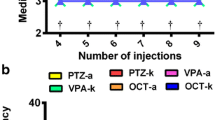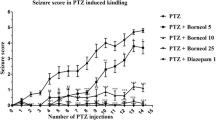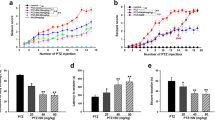Abstract
Epilepsy comes after stroke as the most common chronic neurological disorder worldwide. Inflammation enhances neuronal hyperexcitability that could provide a background setting for the development of epilepsy. The aim of this study was to assess the effect of valproate (VAL), diclofenac (DIC), meloxicam (MEL), VAL + MEL and VAL + DIC in pentylenetetrazol (PTZ) kindled mice. Seventy mice were randomly allocated into 7 equal groups; Control, PTZ, VAL, DIC, MEL, VAL + MEL and VAL + DIC groups. Kindling was induced by PTZ (40 mg/kg, i.p.) injection every other day for 17 days. The drugs were administered, 30 min before each PTZ injection till the end of the schedule. Seizure score, latency, duration and mortality rate were recorded in all groups. Tumor necrosis factor- α (TNF-α), interleukin-1β (IL-1β), malondialdehyde (MDA) and prostaglandin E2 (PGE2) levels as well as reduced glutathione (GSH) content were assessed in brain homogenate at the end of the schedule. VAL, DIC, MEL, VAL + MEL and VAL + DIC decreased seizure score and duration. Meanwhile, they increased the latency period. PTZ increased TNF-α, IL-1β, MDA, and PGE2 levels meanwhile, it decreased GSH content. Administration of VAL, DIC, MEL, VAL + MEL and VAL + DIC decreased TNF-α, IL-1β, MDA, and PGE2 levels meanwhile, they increased GSH content in the brain homogenates. Effects of VAL + DIC combination on the studied parameters were significant in relation to VAL. VAL, DIC, MEL, VAL + MEL and VAL + DIC produced anticonvulsant effect and mitigated inflammation and oxidative stress in PTZ-kindled mice. Interestingly, DIC rather than MEL enhanced the anticonvulsant effect VAL.



Similar content being viewed by others
References
England MJ, Liverman CT, Schultz AM, Strawbridge LM (2012) A reprint from epilepsy across the spectrum: promoting health and understanding. Epilepsy Curr 12(6):245–253
AlyuDikmen FM (2017) Inflammatory aspects of epileptogenesis: contribution of molecular inflammatory mechanisms. Acta Neuropsychiatr 29(1):1–16
Vezzani A, Friedman A, Dingledine RJ (2013) The role of inflammation in epileptogenesis. Neuropharmacol 69:16–24
Vezzani A, Maroso M, Balosso S, Sanchez MA, Bartfai T (2011) IL-1 receptor/Toll-like receptor signaling in infection, inflammation, stress and neurodegeneration couples hyperexcitability and seizures. Brain Behav Immun 25(7):1281–1289
Wilcox KS, Vezzani A (2014) Does brain inflammation mediate pathological outcomes in epilepsy? Adv Exp Med Biol 813:169–183
Shimada T, Yamagata K. (2018). Pentylenetetrazole-induced kindling mouse model. J Vis Exp, 136.
Wahab A (2010) Difficulties in treatment and management of epilepsy and challenges in new drug development. Pharmaceuticals 3(7):2090–2110
Altman R, Bosch B, Brune K, Patrignani P, Young C (2015) Advances in NSAID development: evolution of diclofenac products using pharmaceutical technology. Drugs 75(8):859–877
Tegeder I, Neupert W, Guhring H, Geisslinger G (2000) Effects of selective and unselective cyclooxygenase inhibitors on prostanoid release from various rat organs. J pharmacol Exp Ther 292(3):1161–1168
Vieiraa V, Glassmannb D, Marafonb P, Pereirac P, Gomezc R, Coitinho AS (2016) Effect of diclofenac sodium on seizures and inflammatory profile induced by kindling seizure model. Epilepsy Res 127:107–113
Peretz A, Degani N, Nachman R (2005) Meclofenamic acid and diclofenac, novel templates of KCNQ2/Q3 potassium channel openers, depress cortical neuron activity and exhibit anticonvulsant properties. Mol Pharmacol 67:1053–1066
Darvishi H, Rezaei M, Khodayar MJ, Zargar HR, Dehghani MA, Vardanjani HR, Ghanbari S (2016) Differential effects of meloxicam on pentylenetetrazole- and maximal electroshock-induced convulsions in mice. Jundishapur J Nat Pharm Prod 12(2):e36412
Hakan T, Toklu HZ, Biber N, Ozevren H, Solakoglu S, Demirturk P, Aker FV (2010) Effect of COX-2 inhibitor meloxicam against traumatic brain. Neurol Res 32(6):629–635
Erkec OE, Arihan O (2015) Pentylenetetrazole kindling epilepsy model. Epilepsy 21(1):6–12
Abdel-kader ZY, Khorshid NEA, Abd El motteleb D, Elwany NE (2015) Protective effect of montelukast against pentylenetetrazole induced acute seizures and kindling in mice. ZUMJ 21:6
Almaghour HG, Zawawi NM, Sherif FM (2014) Effect of non-steroidal anti-inflammatory drugs on anticonvulsant activity of diazepam in mice. Pharm pharmacol Int J 1(1):4
Akula KK, Dhir A, Kulkarni SK (2008) Rofecoxib, a selective cyclooxygenase-2 (COX- 2) inhibitor increase pentylenetetrazole seizure threshold in mice: possible involvement of adenosoinergic mechanism. Epilepsy Res 78(1):60–70
Reagan-Shaw NM, Ahmad N (2008) Dose translation from animal to human study should be revisited. FASEB J 22:659–666
Crowther J R. (2009). Stages in ELISA. Methods Mol Bio, 516–78.
Jain S, Bharal N, Khurana S, Mediratta PK, Sharma KK (2011) Anticonvulsant and antioxidant actions of trimetazidine in pentylenetetrazole-induced kindling model in mice. Naunyn Schmiedebergs Arch Pharmacol 383(4):385–392
Prostmann T, Kiessing ST (1992) Enzyme immunoassay techniques. An overview. J Immunol Methods 150:5–21
Shin EJ, Jeong JH, Chung YH, Kim WK, Ko KH, Bach JH (2011) Role of oxidative stress in epileptic seizures. Neurochem Int 59(2):122–137
Reddy AJ, Dubey AK, Handu SS, Sharma P, Mediratta PK, Ahmed QM, Jain S (2018) Anticonvulsant and antioxidant effects of musa sapientum stem extract on acute and chronic experimental models of epilepsy. Pharmacognosy Res 10(1):49–54
Van Den Pol AN, Obrientan K, Belousov A (1996) Glutamate hyperexitability and seizure-like activity throughout the brain and spinal cord upon relief from chronic glutamate receptor blockade in culture. Neuroscience 74(3):653–674
Martinc B, Grabnar I, Vovk T (2014) Antioxidants as a preventive treatment for epileptic process: a review of the current status. Curr Neuropharmacol 12(6):527–550
Gómez CD, Buijs RM, Sitges M (2014) The anti-seizure drugs vinpocetine and carbamazepine, but not valproic acid, reduce inflammatory IL-1β and TNF-α expression in rat hippocampus. J Neurochem 130(6):770–779
Lenz QF, Arroyo DS, Temp FR, Poersch AB, Masson CJ, Jesse AC (2014) Cysteinyl leukotriene receptor (CysLT) antagonists decrease pentylenetetrazol-induced seizures and blood–brain barrier dysfunction. Neuroscience 277:859–871
Maroso M, Balosso S, Ravizza T, Iori V, Wright CI, French J (2011) Interleukin-1beta biosynthesis inhibition reduces acute seizures and drug resistant chronic epileptic activity in mice. Neurotherapeutics 8:304–315
Vezzani A, Granata T (2005) Brain inflammation in epilepsy: experimental and clinical evidence. Epilepsia 46(11):1724–1743
Vezzani A, Aronica E, Mazarati A, Pittman QJ (2013) Epilepsy and brain inflammation. Exp Neurol 244:11–21
Balosso S, Ravizza T, Aronica E, Vezzani A (2013) The dual role of TNF-α and its receptors in seizures. Exp Neurol 247:267–271
He Y, Jackman NA, Thorn TL, Vought VE, Hewett SJ (2015) Interleukin-1β protects astrocytes against oxidant-induced injury via an NF-ĸB-development up regulation of glutathione synthesis. Glia 63:1568–1580
Vezzani A, Balosso S, Ravizza T (2008) The role of cytokines in the pathophysiology of epilepsy. Brain Behav Immun 22:797–803
Suda S, Katsura K, Kanamaru T, Saito M, Katayama Y (2013) Valproic acid attenuates ischemia-reperfusion injury in the rat brain through inhibition of oxidative stress and inflammation. Eur J Pharmacol 707(1–3):26–31
Ximenes JC, Verde EC, Naffah-Mazzacoratti M, Viana GS. (2012). Valproic acid, a drug with multiple molecular targets related to its potential neuroprotective action. Neurosci & Med, 3 (1): Article ID:17746, 14 pages.
Himmerich H, Bartsch S, Hamer H, Mergl R, Schönherr J, Petersein C. (2014). Modulation of cytokine production by drugs with antiepileptic or mood stabilizer properties in anti-CD3- and anti-d40-stimulated blood in vitro. Oxid Med Cell Longev, 806162.
Black JA, Liu S, Waxman SG (2009) Sodium channel activity modulates multiple functions in microglia. Glia 57(10):1072–1081
Khattab MI, Kamel EM, Abbas NAT, Kaoud A (2018) Diclofenac influence on the anticonvulsant effect of retigabine: the potential role of KCNQ channels. Egyptian J Basic Clin Pharmacol 8:1–17
Zhang HJ, Sun RP, Lei GF, Yang L, Liu CX (2008) Cyclooxygenase-2 inhibitor inhibits hippocampal synaptic reorganization in pilocarpine-induced status epilepticus rats. J Zhejiang Univ Sci B 9(11):903–915
Dhir A, Akula KK, Kulkarni SK (2008) Rofecoxib potentiates the anticonvulsant effect of topiramate. Inflammopharmacology 16(2):83–86
Haiju Z, Ruopeng S, Gefei L, Lu Y, Chunxi L (2008) Cyclooxygenase-2 inhibitor inhibits the hippocampal synaptic reorganization by inhibiting MAPK/ERK activity and modulating GABAergic transmission in pilocarpine-induced status epilepticus rats. Med Chem Res 18(2):71–90
Oliveira MS, Furian AF, Royes LF, Fighera MR, Fiorenza NG, Castelli M, Machado P, Bohrer D, Veiga M, Ferreira J, Cavalheiro EA, Mello CF (2008) Cyclooxygenase-2/PGE2 pathway facilitates pentylenetetrazol-induced seizures. Epilepsy Res 79(1):14–21
Holtman L, van Vliet EA, van Schaik R, Queiroz CM, Aronica E, Gorter JA (2009) Effects of SC58236, a selective COX-2 inhibitor, on epileptogenesis and spontaneous seizures in a rat model for temporal lobe epilepsy. Epilepsy Res 84(1):56–66
Patsalos PN. (2010). Drug to Drug Interactions of Antiepileptic Drugs: Mechanisms of Interaction and Management Strategies. In: Panayiotopoulos C.P. (Eds) Atlas of Epilepsies. Springer, London.
Chesné C, Guyomard C, Guillouzo A, Schmid J, Ludwig E, Sauter T (1998) Metabolism of Meloxicam in human liver involves cytochromes P4502C9 and 3A4. Xenobiotica 128(1):1–13
Funding
self-funding.
Author information
Authors and Affiliations
Corresponding author
Ethics declarations
Conflicts of interest
No conflicts of interest.
Additional information
Publisher's Note
Springer Nature remains neutral with regard to jurisdictional claims in published maps and institutional affiliations.
Rights and permissions
About this article
Cite this article
Elgarhi, R., Shehata, M.M., Abdelsameea, A.A. et al. Effects of Diclofenac Versus Meloxicam in Pentylenetetrazol-Kindled Mice. Neurochem Res 45, 1913–1919 (2020). https://doi.org/10.1007/s11064-020-03054-7
Received:
Revised:
Accepted:
Published:
Issue Date:
DOI: https://doi.org/10.1007/s11064-020-03054-7




